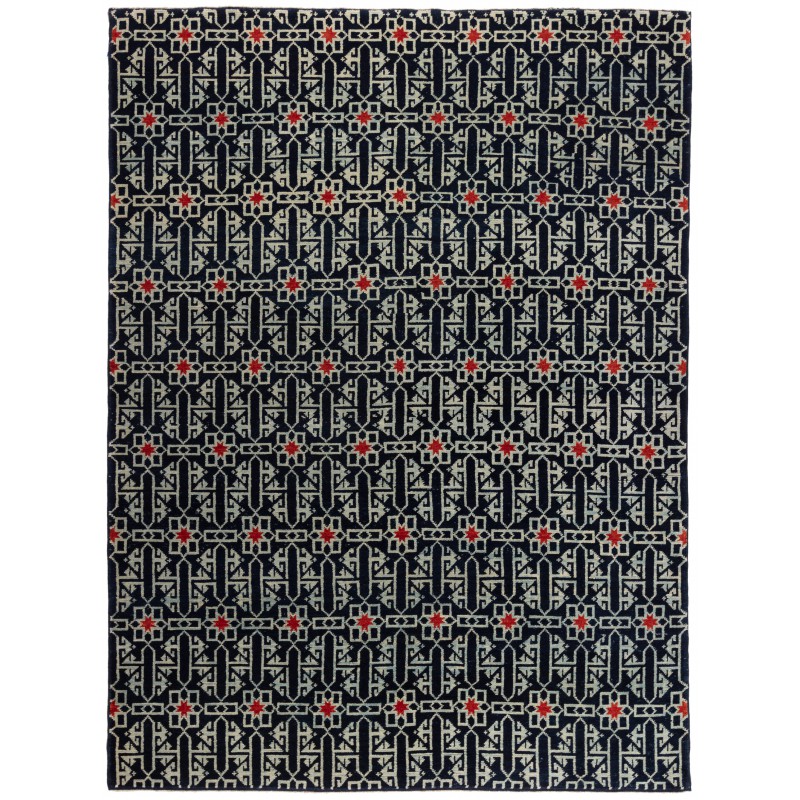
- Stock: In Stock
- Model: C50291
- サイズ: 178cm x 237cm
絨毯の出典は、書籍「オリエント・スターズ・コレクション、アナトリアの部族絨毯1050-1750」、マイケル・フランセス著、Hali Publications Ltd、2021年、図23よりです。この13世紀の絨毯はおそらくアナトリアの中部、コンヤ地域のもので、1200年から1300年頃(C 1290-1420)に作られました。現在はイスタンブールのトルコ・イスラム芸術博物館で展示されています。セルジューク時代は、アナトリアの美術と建築の最高潮の一つを迎えました。そのため、この時代のトルコ結び織物の2つのグループの発見には非常に大きな興奮が起こりました。1905年、フレドリック・ロバート・マーティン(1868-1933)がコンヤのアラッディンモスクで7つの例を発見しました。アラッディンモスクは、12世紀中盤から13世紀中盤にかけて段階的に建設された、スルタン国家の中心に位置する最も重要なモスクです。一般的に「セルジューク」または「アーリーコンヤ」と呼ばれるこれらの絨毯(後のコンヤに帰属される絨毯とは関係ありません)は、早期のアナトリア絨毯の最も重要なグループと考えられるようになりました。その模様は建築物に反映されず、セルジューク朝の美術を代表するものではありません。むしろ、この時期に中央アナトリアに居住していた遊牧民や半遊牧民のトルクメン族の作品と考えられています。したがって、これらを「セルジューク時代の」と呼ぶことがより正確です。4つは大型ですが不完全であり、他の3つは断片的です。これらは1911年にイスタンブールのエヴカフ博物館に移され、その後トルコ・イスラム芸術博物館に収蔵されました。
1908年に彼が3つをカラーで出版した際、マーティンは次のように書いています。「トルコの最も美しいかつ最も古いモスクの一つである1220年に完成したアラルディン(アラッディン)モスクには、他の数百点を覆う数多くの絨毯と異なる4つの絨毯と2つの断片があります。これらは多くの点で異なっていますが、それでも同じ種類であり、同じ時代のものです。彼らの地面は、何度も繰り返される非常にシンプルなパターンで飾られています。これらの絨毯の境界線は、クフィック装飾文字で構成されており、その壮麗な形状と大きさによって、他の絨毯で知られている文字とは全く異なります。明らかにカリフの成立時に使用された壮麗なクフィック文字の流れを受け継いでいます。」私たちのデザイナーはこの絨毯のために柔らかい色合いを選びました。
The source of carpet comes from the book Orient Stars Collection, Anatolian Tribal Rugs 1050-1750, Michael Franses, Hali Publications Ltd, 2021 fig.23. This 13th-century carpet is from probably the Konya region, central Anatolia, circa 1200-1300 (C 1290-1420). It is exhibited at the Museum of Turkish and Islamic Arts, Istanbul. The Seljuk period marks one of the highest points in art and architecture in carpets Anatolia. It is therefore not surprising that tremendous excitement was caused by the discovery of two groups of Turkish knotted-pile carpets from this era. In 1905 seven examples were found by Fredrik Robert Martin (1868-1933) in the Ala’eddin Mosque in Konya, the foremost mosque at the heart of the Sultanate, which was constructed in stages between the mid-12th and mid-13th centuries. Generally referred to as the ‘Seljuk’ or ‘Early Konya’ carpets (although they do not relate to any later carpets that are attributed to Konya), these soon came to be considered the most important group of early Anatolian carpets. Their patterns are not reflected in the architecture and do not represent the art of the Seljuk court; they are more likely the work of one of the nomadic or semi-nomadic Turkmen tribes that inhabited central Anatolia at this time. Labeling them ‘Seljuk-period’ would therefore be more accurate. Four are large but incomplete, the other three are fragmented. They were transferred to the Evkaf Museum in Istanbul in 1911, and then to the Museum of Turkish and Islamic Arts.
In 1908, when he published three of them in color, Martin wrote: ‘In Ala-al-din’s ( Ala’eddin ) Mosque in Konya, which was finished in 1220 AD, are four carpets and two fragments that differ from all others which to the number of several hundred covers the floor of this mosque, one of the most beautiful and most ancient in Turkey. Though in many ways differing, they are nevertheless all of the same kind, and from the same period, viz. contemporaneous with the erection of the mosque. Their ground is decorated with a very simple pattern repeated many times. The border of these carpets, which is their characteristic feature, consists of Kufic decorative letters, which by their pompous form and large size are entirely different from all such letters known on other carpets. They are evidently scions of the magnificent Kufic writing that was in use at the commencement of the Caliphate’. Soft colors are chosen by our designers for this rug.
